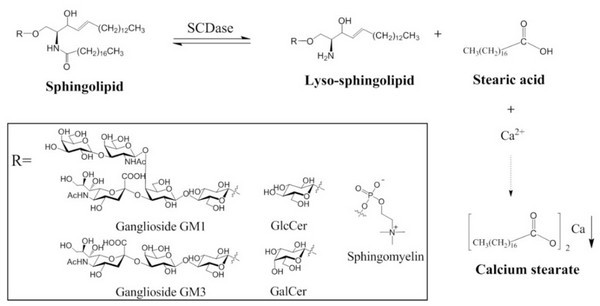Yan Feng’s group made achievements on research of enzymatic production of lyso-glycosphingolipids
Recently, "A facile method for controlling the reaction equilibrium of sphingolipid ceramide N-deacylase for lyso-glycosphingolipid production" was published online in the Journal of Lipid Research. It is the recent research progress on enzymatic method for the production of glycosphingolipids compound made by the research group from School of Life Science and Biotechnology, SJTU and state key laboratory of microbial metabolism. The first author of the research is Huang Fengtao, a doctor from SJTU, and Yang Guangyu, an associate researcher, is his academic advisor.

Glycosphingolipid is an amphipathic glycolipids compound made up by ceramide and oligosaccharide chain through glucosidic bonds and widely participates in the biochemical signaling between cells and surroundings. It plays an important role in each stage of cells, such as proliferation, differentiation, senescence and apoptosis. Glycosphingolipids compound has certain efficacy against some serious disease, such as cancer, neurodegenerative disease, and autoimmune disease etc.. However, as the chemosynthetic methods of lyso-glycosphingolipid is constrained by its complicated process and low productivity, the development of this field was affected.
In previous works, the research group found that N-deacylase for glycosphingolipid of Shewanella algaG8 which is from the marine bacteria can high-effective catalyze the biphasic response of degradation and synthesis of glycosphingolipid chains, which has an important application potential in the synthesis of lyso-glycosphingolipid (Appl Microbiol Biotechnol, 2015, 99(16), 6715-6726 ). As this enzyme coexist the activity of hydrolysis and synthesis and they will compete against each other in catalyzed reaction, which results in the reaction yield only ranges from 40% to 60%. In this research, the enzymatic reaction system of SCDase was optimized. By introducing high concentrations of alk Li-earth metal ion and proper surfactant, the balance of enzyme reaction was successfully controlled. Under the best condition, the conversion rate of SCDase can increase to over 96%. This method is easy to handle and magnify, the productivity of GM1 in 12 hours can increase to 90%, which is significantly above the best results reported in current literatures (72% productivity in two weeks) and shows a promising application in large-scale production and structure innovation of glycosphingolipid drugs.
At present, this technology has applied for China's invention patent. The research group is using efficient synthetic activity and wide substrates selectivity of SCDase to promote many different types of fatty-acid chains and lyso-glycosphingolipid compound non-natural glycosphingolipid molecular library, so as to lay the foundation for the development of more glycosphingolipid drugs with higher efficacy
Viewed:998